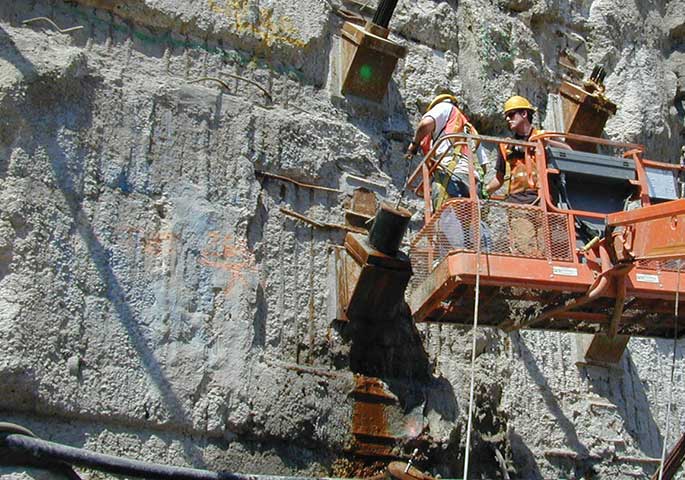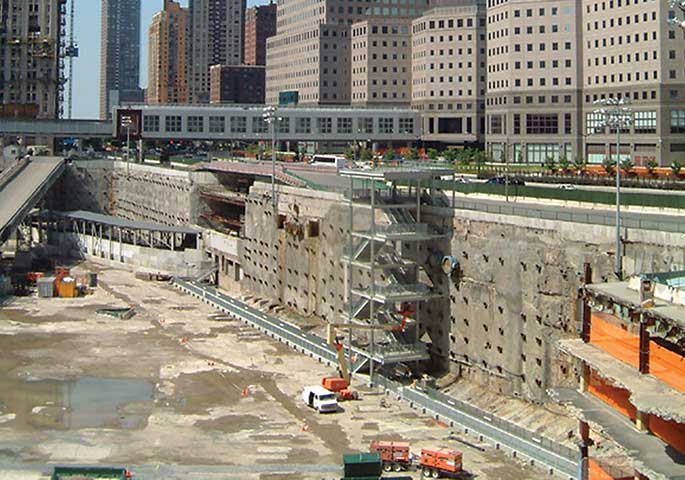September 2016, Vol. 71 No. 9
Rehabilitation
15th Anniversary of 9/11: Sealing The Bathtub - No Small Project

In early 2002, Moretrench American Corporation was asked to essentially save the “Bathtub” section of the destroyed World Trade Center in New York City. Moretrench chose to use Avanti grout for the work.
The bathtub is a nine-block area of the site that was excavated down to bedrock and hard soils and then ringed by a slurry wall to ensure stability of the World Trade Center’s Twin Towers foundations. The bathtub was created to enable construction of the Twin Towers’ foundations and was filled with seven stories of basements housing the parking garage, mall and building services.
Since the groundwater level at the World Trade Center site was just a few feet below the surface, while bedrock was about 70 feet below the surface, creating the bathtub required first building a seven-story dam below the water level of the adjacent Hudson River or what is better known today as the slurry wall.
Leaky problem
After the collapse of the Twin Towers, the concrete floor slabs that had provided structural support for the surrounding soils and groundwater adjacent to the Hudson River were completely destroyed. Without this support, the water pressure being exerted on the surrounding Bathtub was causing the walls to shift, creating leaks of up to 100 to 200 gallons per minute (gpm), and threatening ground loss and structural failure of the Bathtub.

Each section of the Bathtub’s slurry wall consisted of a three-foot thick section that is 22 feet wide and roughly 100 feet below street level. Originally, the walls were held in place externally by temporary tie-backs, and internally the structure of the towers provided the bracing. After the collapse, the only thing supporting the interior walls was the debris itself. As debris removal began, external pressure on the outside of the slurry walls caused many of the panels to shift, moving them as much as 10 inches.
To deal with this problem, New Jersey-based Moretrench, a specialist in groundwater control, was retained to install a dewatering system. Moretrench installed deep dewatering wells to remove the groundwater and alleviate some of the pressures exerted on the walls. Pumps were removing approximately 325,000 gallons a day from the surrounding wells and external soils.
While the dewatering system alleviated some of the problems, significant amounts of groundwater leakage was still finding its way through cracks and holes in the slurry walls. Additionally, approximately 1,000 new tie-backs along the Bathtub walls were necessary to stabilize the structure. However, installation of the tie-backs required boring through the walls and placing new anchors into the surrounding bedrock. This action would have created another avenue for massive water infiltration back into the construction site.
Final solutions
Moretrench was approached for help in solving the problems of the cracks and tie-back penetrations. The solution was use of a single-component, urethane chemical grout called AV-310 Hydro Sealant from Avanti International. The process of sealing the joints and cracks in the slurry walls involved drilling into the structure and bisecting the crack at a 45-degree angle. The chemical grout was then injected into the wet cracks using a high-pressure airless pump.
Since AV310 is a hydrophilic chemical grout, it is attracted to water and continues to absorb water during the reaction process. When it was necessary, dry cracks in the slurry walls were flushed with water by a second pump in order to help the grout activate and begin foaming. The chemical grout reacted quickly and expanded in the cracks to provide a flexible seal and stop the flow of water. According to Moretrench grouting crews, flow of as much as 80 to 90 gpm were stopped by using this hydrophilic chemical grout.
The next issue was the water infiltrating through the tie-backs. For this problem, Moretrench experts had to develop a specialized application to slow the water and keep the chemical grout in place. They cut the excess cable tendons at the tie-back interfaces and fitted each steel housing with a steel cap, injection port and relief valve. High-pressure pumps were then used to inject the same chemical grout directly into the high-pressure flow, forcing it down the cable housing. This technique contained the leaks long enough for the foaming reaction of the chemical grout to occur, which stopped the leaks.

As the 15th anniversary of 9/11 approached, Avanti President Daniel Magill revisited the site. The slurry walls are still in place and the Bathtub houses the memorial museum.
“People around the world wanted to be part of helping at ground zero – wanted to help with search and rescue, help clean up, help rebuild,” Magill reflected.
“Securing the bathtub walls kept the nearby subway from flooding and enabled the crews to move forward. I’m so grateful that we had the opportunity to be part of such an amazing effort and to see the wall featured the way it is as part of the memorial.
“It’s truly humbling.”




Comments